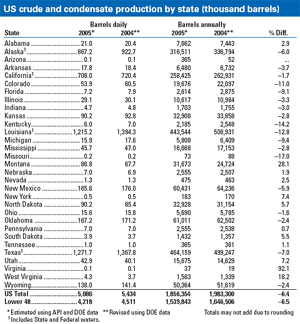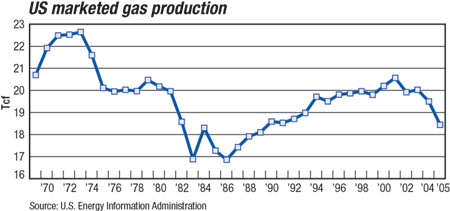OUTLOOK 2006: United States
US production
Hurricanes batter production
Crude and condensate. It’s in production that the effect of the record hurricane season is most apparent. And it’s worth remembering that 2004 had Hurricane Ivan. But that did not compare to the effects of Katrina and Rita. Early results from 2005 show that US crude production fell dramatically, down 6.4%. And this, despite record oil prices that peaked at $70.85. Interestingly, production would have declined even without the hurricanes, though 114 million barrels less, in other words, only 0.6%. Governmental revisions to the last two years would not have changed our original estimates much, so, perhaps our best estimate of 2005’s production will hold as well.
 |
| |
US crude and condensate production by state
Click image for enlarged view |
|
|
|
The Lower 48, absent the hurricanes, would have seen a surprising slight increase. Worthy of note was Montana, which produced 7 million bbl more than last year. It was Alaska that continued its usual bad behavior, as expected, with a 6% drop. A few of the North Slope operators have begun efforts to produce some of the estimated 36 million bbl of heavy oil (~12° to 18°) that lies in the Ugnu, West Sak and Schrader Bluff formations, at a depth of 3,000 to 3,500 ft. This is more than the original oil in place of Prudhoe and Kuparuk fields combined.
Natural gas. Revised data for 2004 show that gas production fell more than originally thought last year. Preliminary year-end 2005 data indicate that gas production was again lower; about 5% or so lower. The graph shows a relatively flat trend, with a bump in 2001 and the hurricane-related falloff in the last two years. So far, 1973 was the peak in US gas production, and no one seems to care. It is now apparent that, as long as E&P operations remain robust, without any interruptions, US gas production will struggle to keep up.
 |
The unconventional gas plays have been a godsend, but the low deliverability of those wells makes it difficult to replace the high-flowrate wells in the Gulf. There is hope, in the form of North Slope gas and LNG. The recent addition of the world’s first offshore LNG terminal, the Gateway Energy Bridge Terminal, 116 mi in the Gulf was badly needed. Chevron plans to build an LNG facility 40 mi out in the Gulf, called Port Pelican. Meanwhile, BP is fighting residents to build its Pelican Island facility near Galveston, Texas. In addition to the nation’s five operating LNG terminals, there are seven more approved by, plus another 20 proposed to, various federal agencies. 
|




